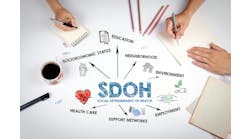The year 2021 has been an eventful one for New York-based Unite Us, a company that is working to build an operating system for social care to improve health. The company acquired analytics firm Carrot Health and competitor NowPow, bringing its headcount to more than 800 and creating the largest U.S. integrated health and social network. In a recent interview with Healthcare Innovation, Dan Brillman, the company’s CEO and co-founder, described its evolution and vision.
Unite Us has developed partnerships with state governments, nonprofit organizations and large health systems including Kaiser Permanente. For instance, Unite Louisiana uses the Unite Us technology platform to connect clinicians and social service providers to serve the health and social needs within communities and parishes statewide.
Healthcare Innovation: Could you tell us about the company’s origin story? How was it able to gain a foothold in this space and then the momentum to forge relationships?
Brillman: We started in 2013. Prior to that, my co-founder and I were trying to help veterans and military families that we served with solve problems with healthcare, governmental benefits and social services. We had a lot of struggles trying to connect them with all these different services. We saw how fragmented it all was. It required a lot of calls on their behalf, telling their story over and over again to different organizations. There was no connectivity across all three, and most importantly, no one could ever answer the question, “Did my client ever get there?” So we started to build networks that brought these organizations together into an accountable and quality-focused ecosystem.
Did you start in certain geographies to try to solve that problem and then expand out?
We started in New York City. That network is now almost a decade old. After that, we scaled that to about 15 different cities to include four regions of North Carolina. Then health plans and health system started asking the community-based organizations on our networks if they could start connecting because their patients need food, they need housing, and it's impeding their patients’ health and leading to higher costs. We were already ready to expand in that nature; we already had the product; we had already worked on the ground to solve the technology issues and programmatically to standardize. Our expansion meant we started selling to healthcare, insurers, larger HHS governments and city governments to build this infrastructure across the country for all populations.
Was there a moment or a period when you realize the platform was having this big impact and knitting together the healthcare and community organizations in a new way, that was gratifying to see?
In the first five years of our business just focused on veterans, we did a study looking at how long it would take a client to even get to another organization when there was no technology, and they had to self-navigate and tell their story over again. On average it was about 16 days. Fast forward, when we look at network health and statistics today, 50 percent of people are getting accepted within the same day, because technology has connected all those nodes, and 84 percent of the time they can get enrolled in the same week across 155 different types of services. Now providers can see what happens and how fast it happens on the other side [of a referral], which is monumental. In 2021, we're looking at much deeper metrics around utilization. In New York there has been a 16 percent reduction in ED visits, because social service providers are closer to clients and are often first people called. Even nine years ago we would bring clients in the network to come speak to the service providers about how this changed their life — not just how about how it made their health better, it changed their life. Because these are things that they needed to get them back on their feet.
Are there health technology issues you had to work through in terms of interoperability of data?
The first thing we had to do was to basically automate what should happen in real life. You can't expect every service provider to connect with hundreds of organizations and know exactly how to treat each piece of information. It's impossible to tell a nurse in a hospital how to share information with a housing vs. a substance use clinic. That was a lot of hard work. We also had to live inside systems of record, such as medical record systems like Epic and Cerner, to interoperate. We always needed to keep the user's workflow in mind. We didn't want to medicalize community-based organizations where all of a sudden they're getting faxes through an EMR. We wanted to make sure it's staying in the flow of how they've used our system, because it is not just about catching referrals from the healthcare provider; it is also about working with each other from housing to employment to financial assistance and transportation. We also provide them data and analytics and dashboards to prove their impacts back to their funders and stakeholders.
Now we've launched Unite Us Payments, so that the same organizations on our system that are already working together and reporting back outcomes can get reimbursed through us, which is really an important part of where we're going. We are aligning financial incentives between this whole governance structure in a state where everyone's working together. I'll give you an example. North Carolina, one of our first statewide deployments three years ago, is now putting $650 million into non-clinical services through a payments mechanism, which is run by our system.
Is that part of the North Carolina’s recent switch to Medicaid managed care?
Yes, we are the network of the organizations that can communicate and report back outcomes. Now they can use the same system, without having to change their workflows or medicalize what they're doing, to actually drive automated invoices and a claim that they can get paid for.
I saw a press release in July about how you were expanding your product suite with an end-to-end social care solution. Can you describe that?
As customers start understanding where their members are going, the natural thing that they started asking was how can I know which clients should I be telling about the network today? For us, that meant how do we move upstream to be able to determine which of your member base should be getting into the network now. If someone is on the street and homeless, it's an emergency crisis that we need to fix, but the question is, could we have gotten to that person a year prior, when they were at risk for homelessness? Our predictive analytics can tell us that, and we can do proactive outreach to get them in our network and get that solved before it becomes a crisis. That's why we acquired Carrot Health, which was the leader in this work around predictive analytics.
You mentioned the acquisition of Carrot Health. Another big acquisition this year was NowPow. Were they a direct competitor or were they targeting different audiences or doing slightly different things? What was the interest in combining the two?
They were definitely in the same space, and we were very respectful of each other in the industry. NowPow started out in the clinical setting. Most of their customers have been medical providers going back nine years. They were in the healthcare space even before we expanded out of the veteran space. We started on the community side. Healthcare was part of it, but it was not leading with healthcare, so combining those two things was the beautiful part of bringing us together. Clinical workflows and community-based workflows — it kind of brought the ecosystem together. I think it reduced more silos that may have been created when markets are created around this. We're all trying to do what's best for the communities and the customers we had, so this kind of reduced the fragmentation. Also geographically, it brought us to all 50 states.
The HL7 Gravity Project is trying to get some coded structured elements in EHRs that relate to the social determinant data to make it easier to share and to quantify. Do you see that as important work?
Absolutely. What we have done as a company is standardize how this sharing happens at scale between different stakeholders. What the Gravity Project is doing is really helping with codifying elements that are brought into the medical setting, which have not been standardized in a good way. That allows for better exchange and better measurement and standardization at scale for the medical world around social care.
Are there things on your wish list that CMS or the Center for Medicare and Medicaid Innovation could do to incentivize this work to grow even faster than it has been?
I'm excited about the tailwinds already. There are more than 30 states mandating this type of work, not just resource directories, but you need to actually go the last mile and prove the impact for your members or your patients, which requires a real closed-loop, accountable network. The next question is: what is everyone's participation in this financially? I think that's going to be really important going forward. How do we include this type of infrastructure and payment model in the medical loss ratio? What payers want to know is how do I actually put this into actual health spend, right? If this is really health and we're investing in this just like a knee surgery, they should be able to pay for this just like anything else, which is really important. Now, is that at scale yet? No, but it's happening in North Carolina and in California starting next year.
Plus, CMS has said that they want to make health equity central to all the alternative payment models that they create. It seems like this is a way to help people who are underserved traditionally. You want to reach out to those people, and this is one way to do it.
We talk about the flexibilities of what insurance companies or health systems or governments can invest in, and we're seeing that in Medicare Advantage where they are paying for things like food boxes that are obviously not traditional in nature on the medical side. It also involves quality measures — when incentives are aligned and we talk about value-based care, we're all excited about the outcome. The outcome should include how we address the whole person, and I think we're on the way there, but more measures around social care are going to be important to reducing inequities.


